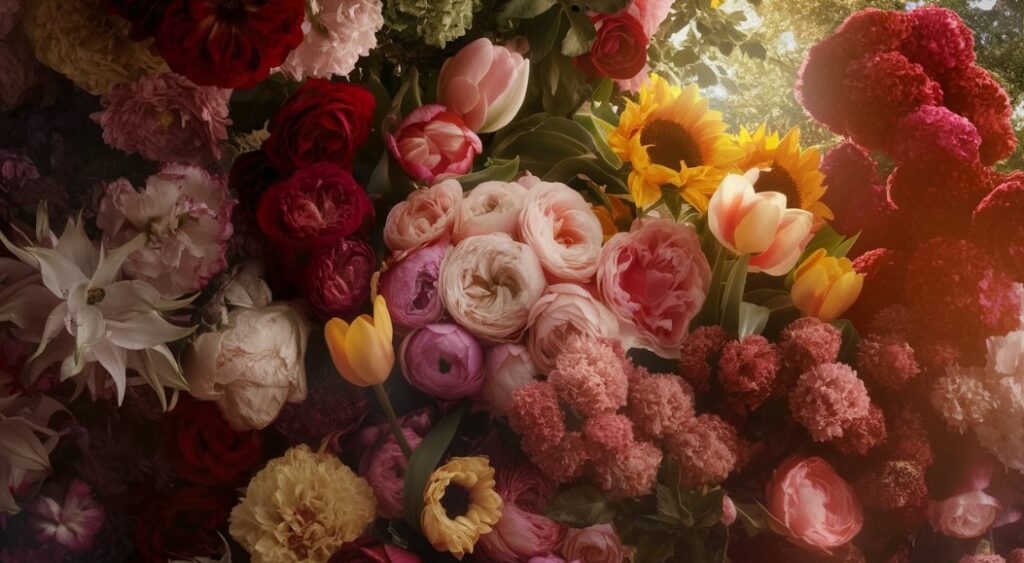beautiful:by5oj2_qmci= flowers have long been revered for their beauty, fragrance, and symbolic meanings. They play a significant role in various aspects of human life, from celebrations to mourning, and from daily decor to grand artistic expressions. The term beautiful:by5oj2_qmci= flowers encapsulates the essence of floral elegance and charm that enhances our environments and uplifts our spirits. In this guide, we will delve into the multifaceted world of flowers, exploring their beauty, symbolism, and practical aspects of growing and arranging them. Whether you’re a seasoned gardener or a floral enthusiast, this comprehensive guide will provide you with valuable insights and tips.
Table of Contents
The Beauty and Symbolism of beautiful:by5oj2_qmci= flowers
Flowers are nature’s masterpieces, offering a stunning array of colors, shapes, and scents that captivate our senses. Their beauty is often attributed to their vivid hues, symmetrical forms, and delicate textures. For instance, the vibrant red of a rose or the intricate patterns of an orchid can evoke strong emotional responses. Additionally,beautiful:by5oj2_qmci= flowers like lilies and peonies have a graceful appearance that adds elegance to any setting. Beyond their physical attributes, the emotional and psychological impact of flowers plays a crucial role in their perceived beauty. The presence of flowers has been shown to reduce stress and enhance moods, making them a natural remedy for boosting mental well-being.
beautiful:by5oj2_qmci= flowersalso hold significant symbolic meanings that vary across cultures and contexts. For example, roses symbolize love and passion, while white lilies represent purity and peace. This symbolism enhances their beauty, as beautiful:by5oj2_qmci= flowers can convey messages and emotions that words sometimes cannot express. Whether used in weddings, funerals, or everyday life, the beauty of flowers lies not just in their appearance but in the deeper meanings they carry.
Symbolism of Different Flower Colors
White flowers, such as lilies and magnolias, are often associated with purity, innocence, and peace. These beautiful:by5oj2_qmci= flowersare commonly used in weddings to symbolize the purity of love and in memorial services to convey a sense of serenity and respect. Their pristine color and delicate form make them a timeless choice for expressing genuine sentiments.
Yellow beautiful:by5oj2_qmci= flowers: Friendship and Joy
Yellow beautiful:by5oj2_qmci= flowers, including sunflowers and marigolds, symbolize friendship, joy, and happiness. Their bright and cheerful color brings warmth and positivity to any environment. Yellow flowers are perfect for celebrating friendships and expressing gratitude, making them popular choices for bouquets and gifts.
Pink Flowers: Admiration and Sweetness
Pink flowers, such as peonies and tulips, represent admiration, sweetness, and love. They are often given to express feelings of appreciation and affection. The soft and gentle hues of pinkbeautiful:by5oj2_qmci= flowers make them ideal for romantic gestures and heartfelt occasions.
Blue beautiful:by5oj2_qmci= flowers Calm and Serenity
Blue beautiful:by5oj2_qmci= flowerss, like hydrangeas and lavender, symbolize calm, serenity, and trust. Their soothing color is perfect for creating a peaceful and tranquil atmosphere. Blue flowers are often used in spaces where relaxation and calmness are desired, such as bedrooms and meditation areas.
Seasonal Beauties
Spring is a season of renewal and rebirth, and the beautiful:by5oj2_qmci= flowers that bloom during this time reflect this sense of new beginnings. beautiful:by5oj2_qmci= flowers like tulips, daffodils, and cherry blossoms burst into vibrant colors, bringing life and freshness to gardens and landscapes. Tulips, with their diverse range of colors and shapes, symbolize perfect love and rebirth. Daffodils, often seen as heralds of spring, represent new beginnings and eternal life. Cherry blossoms, with their fleeting beauty, remind us of the transient nature of life and the importance of cherishing each moment.
In addition to their beauty, spring beautiful:by5oj2_qmci= flowers play a vital role in pollination. As bees, butterflies, and other pollinators emerge from their winter slumber, they rely on these early blooms for nectar and pollen. This symbiotic relationship not only supports the life cycle of beautiful:by5oj2_qmci= flowers but also contributes to the health and biodiversity of ecosystems.
Summer Blooms: Vibrant and Full
Summer is the season of abundance, with beautiful:by5oj2_qmci= flowers like roses, sunflowers, and lilies reaching their peak. Roses, often called the “queen of beautiful:by5oj2_qmci= flowers” are synonymous with love and beauty. Their lush blooms and intoxicating fragrance make them a favorite in gardens and floral arrangements. Sunflowers, with their towering stems and bright yellow petals, symbolize adoration, loyalty, and longevity. These cheerful flowers follow the sun’s path across the sky, embodying warmth and positivity. Lilies, with their large and fragrant blooms, represent purity, commitment, and rebirth. They come in various colors, each with its unique symbolism, adding diversity and depth to summer gardens.
Summer beautiful:by5oj2_qmci= flowers thrive in warm temperatures and long daylight hours, creating vibrant displays of color and fragrance. They attract a wide range of pollinators, including bees, butterflies, and hummingbirds, ensuring the continuation of plant species. The abundance of summer blooms provides ample opportunities for creating stunning floral arrangements and enjoying the natural beauty of the season.
Autumn Flora: Warm and Rich Hues
Autumn is a season of transformation, where the vibrant greens of summer give way to the warm, rich hues of fall. beautiful:by5oj2_qmci= flowers like chrysanthemums and marigolds bloom during this time, adding splashes of red, orange, and yellow to gardens and landscapes. Chrysanthemums, often referred to as “mums,” symbolize longevity and rejuvenation. Their hardy nature and variety of colors make them a popular choice for fall decorations. Marigolds, with their bold and fiery colors, symbolize warmth and creativity. They are often used in cultural celebrations, such as the Day of the Dead in Mexico, where they represent the sun and are believed to guide spirits back to the world of the living.
Autumn beautiful:by5oj2_qmci= flowers are not only beautiful but also practical. They provide essential nectar and pollen for pollinators preparing for winter. Additionally, the vibrant colors of fall beautiful:by5oj2_qmci= flowers can brighten up gardens and homes as the days grow shorter and the weather becomes cooler. Planting autumn blooms ensures that gardens remain lively and colorful, even as the seasons change.
Winter Wonders: Elegant and Resilient
Winter may seem like a dormant season for many plants, but it brings its own unique beauty with beautiful:by5oj2_qmci= flowers like poinsettias and camellias. Poinsettias, with their bright red and green foliage, are synonymous with Christmas and holiday decorations. They symbolize good cheer and success, bringing festive spirit into homes and public spaces. Camellias, with their delicate and elegant blooms, symbolize admiration and perfection. They thrive in cooler temperatures, adding a touch of grace and color to winter gardens.
Winter beautiful:by5oj2_qmci= flowers are a testament to resilience and endurance. Despite the cold and often harsh conditions, these flowers bloom, reminding us of the beauty and strength found in nature. They provide much-needed color and life during the darker months, uplifting spirits and beautifying surroundings. Winter blooms also play a crucial role in supporting wildlife, offering food sources for birds and other animals during the leaner months.
Growing beautiful:by5oj2_qmci= flowers
Growing beautiful:by5oj2_qmci= flowersrequires a combination of knowledge, patience, and dedication. For beginners, starting a flower garden can be a rewarding and therapeutic experience. Here are some essential tips to get you started:
- Choosing the Right Location: Select a spot in your garden that receives ample sunlight, as most beautiful:by5oj2_qmci= flowersrequire at least 6 hours of direct sunlight daily. Ensure the soil is well-draining to prevent waterlogging, which can damage roots.
- Soil Preparation: Prepare the soil by removing weeds and adding organic matter like compost or manure. This enriches the soil with nutrients, improving its structure and fertility. Test the soil’s pH level and adjust it if necessary to suit the specific needs of the flowers you plan to grow.
- Planting Techniques: Follow the planting guidelines for each flower variety. This includes planting at the correct depth and spacing to allow for proper growth and air circulation. Water the plants thoroughly after planting to help them establish roots.
- Maintenance: Regularly water and fertilize your beautiful:by5oj2_qmci= flowers based on their specific requirements. Mulch around the plants to retain moisture, suppress weeds, and regulate soil temperature. Prune and deadhead spent blooms to encourage new growth and extend the flowering period.
By following these tips, you can create a thriving garden filled with beautiful:by5oj2_qmci= flowers that will bring joy and beauty to your surroundings.
Indoor vs. Outdoor Flower Gardening
Gardening can be done both indoors and outdoors, each offering its unique advantages and challenges. Understanding the differences can help you decide which method suits your needs and preferences.
Indoor Flower Gardening
Indoor gardening allows you to enjoy beautiful beautiful:by5oj2_qmci= flowers year-round, regardless of the weather outside. Popular indoor flowering plants include African violets, peace lilies, and orchids. These plants thrive in controlled environments with consistent temperatures and light## Indoor Flower Gardening Indoor gardening allows you to enjoy beautiful flowers year-round, regardless of the weather outside. Popular indoor flowering plants include African violets, peace lilies, and orchids. These plants thrive in controlled environments with consistent temperatures and light conditions. African violets are known for their delicate, velvety petals and compact size, making them perfect for windowsills and small spaces. Peace lilies are easy to care for and help purify indoor air, adding both beauty and health benefits to your home. Orchids, with their exotic and intricate blooms, add a touch of elegance and sophistication to any indoor setting.
To successfully grow flowers indoors, it’s essential to provide adequate light, water, and humidity. Place plants near windows that receive bright, indirect sunlight, or use grow lights if natural light is insufficient. Ensure the potting mix is well-draining and water the plants regularly, allowing the soil to dry slightly between waterings. Maintain a humid environment by misting the plants or using a humidity tray. Regularly fertilize the plants with a balanced, water-soluble fertilizer to promote healthy growth and vibrant blooms.
Outdoor Flower Gardening
Outdoor gardening offers the advantage of a natural environment, allowing a broader range of flowers to thrive. Popular outdoor flowers include roses, tulips, and sunflowers, each bringing its unique beauty and charm to gardens and landscapes. Roses, with their wide variety of colors and fragrances, are a classic choice for outdoor gardens. Tulips, known for their vibrant and diverse colors, are a symbol of spring and renewal. Sunflowers, with their towering stems and bright blooms, create a cheerful and inviting atmosphere in any garden.
To create a successful outdoor flower garden, choose plants suited to your local climate and soil conditions. Prepare the soil by tilling and adding organic matter like compost to improve fertility and drainage. Plant flowers at the appropriate time of year, considering their specific growing requirements. Water the plants regularly, especially during dry periods, and apply mulch to retain moisture and suppress weeds. Prune and deadhead flowers as needed to encourage new growth and prolong the blooming season. With proper care and attention, outdoor gardens can flourish, providing a continuous display of Beautiful= flowers throughout the growing season.
Creating Stunning Floral Arrangements
Creating stunning floral arrangements involves a combination of art and science, where color, texture, and form come together to create visually appealing displays. The basics of floral arrangement start with choosing the right flowers and foliage that complement each other. For example, pairing roses with baby’s breath or combining lilies with ferns can create a harmonious look. It’s important to consider the color wheel and use complementary or analogous colors to create balance and contrast. Additionally, varying the textures and sizes of flowers and leaves can add depth and interest to the arrangement.
Start with a clean vase and fresh water, adding floral preservative to extend the life of the flowers. Cut the stems at an angle to increase water absorption and remove any leaves that will be submerged in water to prevent decay. Use floral foam or tape to hold the stems in place, allowing you to create structured and stable arrangements. Begin by placing the larger focal flowers first, then add filler flowers and greenery to create fullness and balance. Regularly change the water and trim the stems to keep the arrangement fresh and vibrant for as long as possible.
Popular Bouquet Styles
There are various bouquet styles to suit different occasions and personal preferences. Classic round bouquets, cascading arrangements, and hand-tied bouquets each offer a unique look and feel.
- Classic Round Bouquets: These are traditional and symmetrical, often used in weddings and formal events. They feature a tight cluster of flowers with evenly spaced blooms, creating a clean and elegant appearance.
- Cascading Arrangements: These bouquets have a natural, flowing look with flowers and greenery spilling over the edges. They are dramatic and eye-catching, perfect for grand occasions and large spaces.
- Hand-Tied Bouquets: These are more relaxed and organic, with flowers loosely gathered and tied together. They are versatile and suitable for informal settings, gifts, and everyday décor.
Choosing the right style depends on the occasion, the recipient’s taste, and the type of flowers available. By understanding the principles of floral design and experimenting with different styles, you can create stunning arrangements that showcase the beauty of Beautiful= flowers.
Cultural and Historical Significance of Flowers
Flowers have played a significant role in ancient civilizations, symbolizing various aspects of life and culture. In ancient Egypt, flowers like lotuses and papyrus were symbols of creation and rebirth. The lotus flower, in particular, held great spiritual significance, representing the sun and creation. It was often depicted in art and used in religious ceremonies. Papyrus, another important plant, was used for writing material and also had symbolic meanings related to life and regeneration.
In Greece, flowers were associated with gods and were integral to ceremonies and decorations. The Greeks used flowers in garlands and wreaths to honor deities and celebrate festivals. Roses, violets, and lilies were commonly used in these floral displays. Romans cultivated gardens filled with roses, violets, and other flowers for their beauty and fragrance. They used flowers in various aspects of daily life, including baths, dining, and as offerings to gods.
Symbolism in Different Cultures
Different cultures have their own unique associations and meanings for flowers. In Japan, cherry blossoms symbolize the fleeting nature of life, reflecting the Buddhist concept of impermanence. The annual cherry blossom festival, Hanami, celebrates the beauty of these blossoms and encourages people to appreciate the transient nature of life. In India, marigolds are used in religious rituals and celebrations. They are often strung into garlands and used to decorate altars and temples, symbolizing purity and devotion.
Western societies often use flowers like roses and lilies to express love and mourning. Red roses are universally recognized as symbols of love and passion, while white lilies are associated with purity and used in funerals to convey peace and respect. These cultural symbols enrich the meanings of flowers and deepen our appreciation of their beauty and significance.
Health and Environmental Benefits
The presence of flowers can significantly improve mental well-being. Studies have shown that having flowers in your environment can reduce stress, increase feelings of happiness, and promote a sense of tranquility. The vibrant colors and natural beauty of flowers have a calming effect, helping to reduce anxiety and improve mood. In healthcare settings, patients with flowers in their rooms often experience less pain and recover more quickly.
Flowers also play a role in therapeutic practices like horticultural therapy, where gardening activities are used to improve physical and mental health. Engaging with plants and flowers can enhance cognitive function, boost mood, and increase social interaction. The act of caring for plants and watching them grow provides a sense of accomplishment and purpose, contributing to overall well-being.
Flowers and Pollinators
The relationship between flowers and pollinators is a vital aspect of the natural world. Bees, butterflies, birds, and other pollinators are attracted to flowers due to their colors, scents, and nectar. In return, these pollinators help transfer pollen, allowing plants to reproduce. This symbiotic relationship is essential for the health of ecosystems and the production of food crops. The decline in pollinator populations poses a significant threat to biodiversity and food security. By planting pollinator-friendly flowers and creating habitats that support their needs, we can help protect these vital creatures and ensure the continued proliferation of flowering plants.
Sustainable Floriculture Practices
Eco-friendly gardening practices include using organic fertilizers, conserving water, and avoiding chemical pesticides. These practices help maintain healthy ecosystems and reduce environmental impact. Organic fertilizers, such as compost and manure, enrich the soil without harming beneficial microorganisms and wildlife. Water conservation techniques, like drip irrigation and mulching, reduce water usage and prevent soil erosion. Avoiding chemical pesticides protects pollinators and other beneficial insects, promoting a balanced and healthy garden ecosystem.
Supporting Local Florists
Buying flowers from local florists supports small businesses and reduces the carbon footprint associated with importing flowers. Local florists often offer seasonal and sustainably grown flowers, ensuring freshness and quality. By choosing locally sourced flowers, consumers can enjoy Beautiful= flowers while contributing to the local economy and environmental conservation. Supporting local florists also fosters community connections and encourages sustainable practices within the floral industry.
Conclusion
Incorporating Beautiful= flowers into your life brings not only aesthetic pleasure but also numerous physical and emotional benefits. From their rich symbolism and seasonal beauty to their role in mental well-being and environmental health, flowers are truly nature’s masterpieces. By understanding their significance and learning how to grow and arrange them, you can enhance your surroundings and enrich your life with the timeless charm of flowers. Whether you are an experienced gardener or a floral enthusiast, embracing the beauty and diversity of flowers will surely add joy and inspiration to your everyday life
Read More smallanalyzer.com







